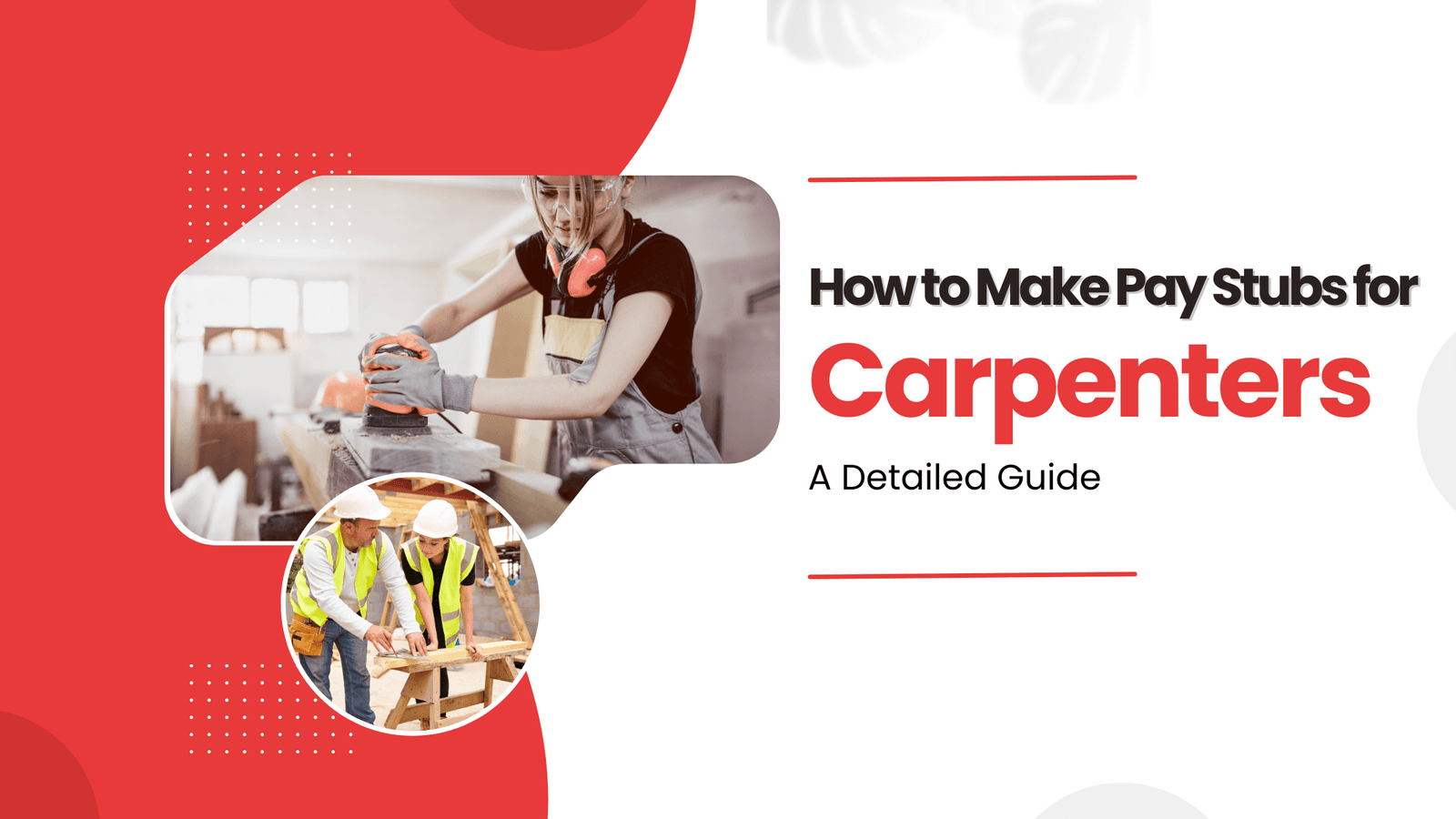You’re a carpenter—having your pay stubs in order is a professional issue as well as a compliance and financial concern. Pay stubs are crucial because they are legal proof of the earnings and payroll deductions, taxes, and other related items. Whether you work for a contractor or you are an independent contractor, knowing how to make carpenters’ pay stubs will provide transparency, keep you organized, and better position you to meet any legal requirements.
This guide will help you with providing accurate pay stubs, how it benefits carpenters, and a step-by-step view of what to include in your carpenter’s pay stub.
Understanding Pay Stubs for Carpenters
A carpenter’s pay stub is an itemized statement of wages received for work performed over a given period. It contains details about hours worked, hourly wages or salary, deductions and taxes, and total compensation received by the employee. For carpenters who do frequent project-based work or join a crew working for many contractors, a pay stub helps keep finances in order.
Not only do carpenter pay stubs represent what you earned, but they also help keep you in compliance with labor laws, obtain loans, or file taxes. By using correct pay stubs, carpenters can guarantee they get honest pay for their work and also prove their income when needed.
Significance Of The Pay Stub For The Carpenters
- Record-keeping: It gives you a record of what you have made, which can be helpful for budgeting and planning.
- Legal Compliance: All employers must provide their employees with pay stubs. For the purpose of seeing to it that wages were paid according to the law.
- Proof of Income: One must have pay stubs to prove his/her income for loan applications, rental applications, or when considering taxes.
- Tax Summary: This portion of your pay stub includes deductions for both income taxes and social security and any other taxes, giving you peace of mind that you are paying what you should and making it simple to file taxes.
How to Make Pay Stubs for Contractors
It is possible to prepare a carpenter’s pay stub manually or by using a template. And you can make one for yourself:
Collect Necessary Information
Before you put together a carpenter’s paycheck or pay stub, collect all the relevant information. This includes:
- Carpenter’s Name: The name of the carpenter or worker for whom the check is being made out.
- Pay Period: The length of time for which you are paid (weekly, biweekly, or monthly).
- Total Time Worked: The sum of hours that you worked for the pay period.
- Hourly Rate/Annual Earnings: What you earned per hour or annually in the given term. If you’re a contractor, the rate could also be variable depending on the nature of the work.
- Overtime: Hours—Indicate any overtime hours worked and the rate of overtime, if any.
- Bonuses or Tips: Tips or bonuses you earned for services rendered.
List Deductions
Deductions are subtracted from your gross pay and can include:
- Deductions: Federal, state, and local taxes are normally taken out of your check. Make sure you selected the right tax percent.
- Social Security and Medicare: These taxes are withheld from your paychecks and are crucial elements of your future benefits.
- Retirement Contributions: If you contribute to a retirement plan such as a 401(k) employer-sponsored plan.
- Other Voluntary: You could also add health coverage, union dues, or something else that is voluntary.
Calculate Gross and Net Pay
- Gross Pay: This is the amount you made before all the other stuff was deducted. For a carpenter, this would be the gross hours multiplied by the hourly rate (including any overtime or bonuses).
- Net Pay: If you were to take all deductions out, the amount you take home after all taxes and fees have been paid is called your net pay. This is the total that will actually get deposited or handed to you.
Include Employer Information (If Applicable)
If you are an employee of an employer or contractor, the pay stub must include the:
- Name of Employer and Address: Full name of the employer or the contracting company and their complete address.
- Employer’s Tax ID: The company’s federal tax ID or EIN.
- Date of Pay: The date the pay is actually received.
Final Pay Stub Layout
After gathering all of the required information, your pay stub format might look something like the following:
- Employee details: your name, address, and ID number.
- Pay Period: Specifically write down the dates when the pay period ends and begins.
- Gross Pay: The sum of the amount you earned in the pay period, less any deductions.
- Deductions: Group deductions by their tax, benefit, etc. types.
- Net Pay: What you will actually take home.
- Employer: The name and address of the employer, if applicable.
A few carpenters’ pay stubs also include line items for sick days, accrued leave, and vacation time.
Use Pay Stub Generators (Optional)
If you don’t want to do all the math yourself, online pay stub generators can do the work for you. With these utilities, you can enter your details to produce professional pay slips, which are both correct and adhere to the law. They are able to do the math for you and offer a simple-to-understand pay stub for each period.
Review for Accuracy
Once you’ve generated your pay stub, make sure all details are accurate. Verify the number of hours worked, the deductions, and your total pay to make sure everything is consistent with your agreement or contract.
Advantages of Using Pay Stubs for Carpenters
In addition to being necessary for legal compliance purposes, you may find that there are specific carpenter pay stub benefits you can leverage:
Proof of Income
Whether you are applying for a loan, rental, or filing taxes, if you’re asked to show proof of income, a carpenter’s paycheck is an excellent document.
Transparency
Pay stubs are a way to ensure clarity and transparency between yourself and your employer (or client). This implies you both have something to show agreement on, that work was done, and for how much.
Simplifies Tax Filing
When it is time to file your taxes, it is also helpful to have precise pay stubs for carpenters. It was easy for you to view how much you earn and how much is being deducted, ensuring you are filing the complete tax return.
Record for Future Use
Pay Stubs as You Grow Your Carpentry Career. As you pursue a career in carpentry, your pay stubs become invaluable. You can use them for performance growth, for salary increases, or whenever something changes in your work situation.
Conclusion
If you are self-employed as a carpenter, work as part of a construction crew, or work with a contractor, it is extremely important to have an accurate pay stub on hand. They don’t just help make sure you’re getting paid fairly and legally; they are very helpful to have on hand for financial and tax purposes.
You can also make single pay stubs manually or through a pay stub maker as needed. Regardless of the method, be sure your pay stub is accurate for your wages, taxes, and net pay. In the process, you’ll keep your finances sorted, maintain transparency with clients or employers, and keep on the right side of regulations.
How to Create Pay Stubs for Tattoo Artists: A Step-by-Step Guide
FAQ's
Why do carpenters need pay stubs?
+
Pay stubs provide proof of income, help with tax filing, and build trust between carpenters and contractors or clients.
What information should be included on a carpenter’s pay stub?
+
Include gross wages, deductions, taxes, net pay, pay period dates, and company and employee details.
Can I create carpenter pay stubs without accounting software?
+
Yes! You can use online pay stub generators that simplify the process without needing advanced accounting tools.
Are digital pay stubs acceptable for carpenters?
+
Absolutely. Digital pay stubs are legally valid and often more convenient for storage and sharing.






